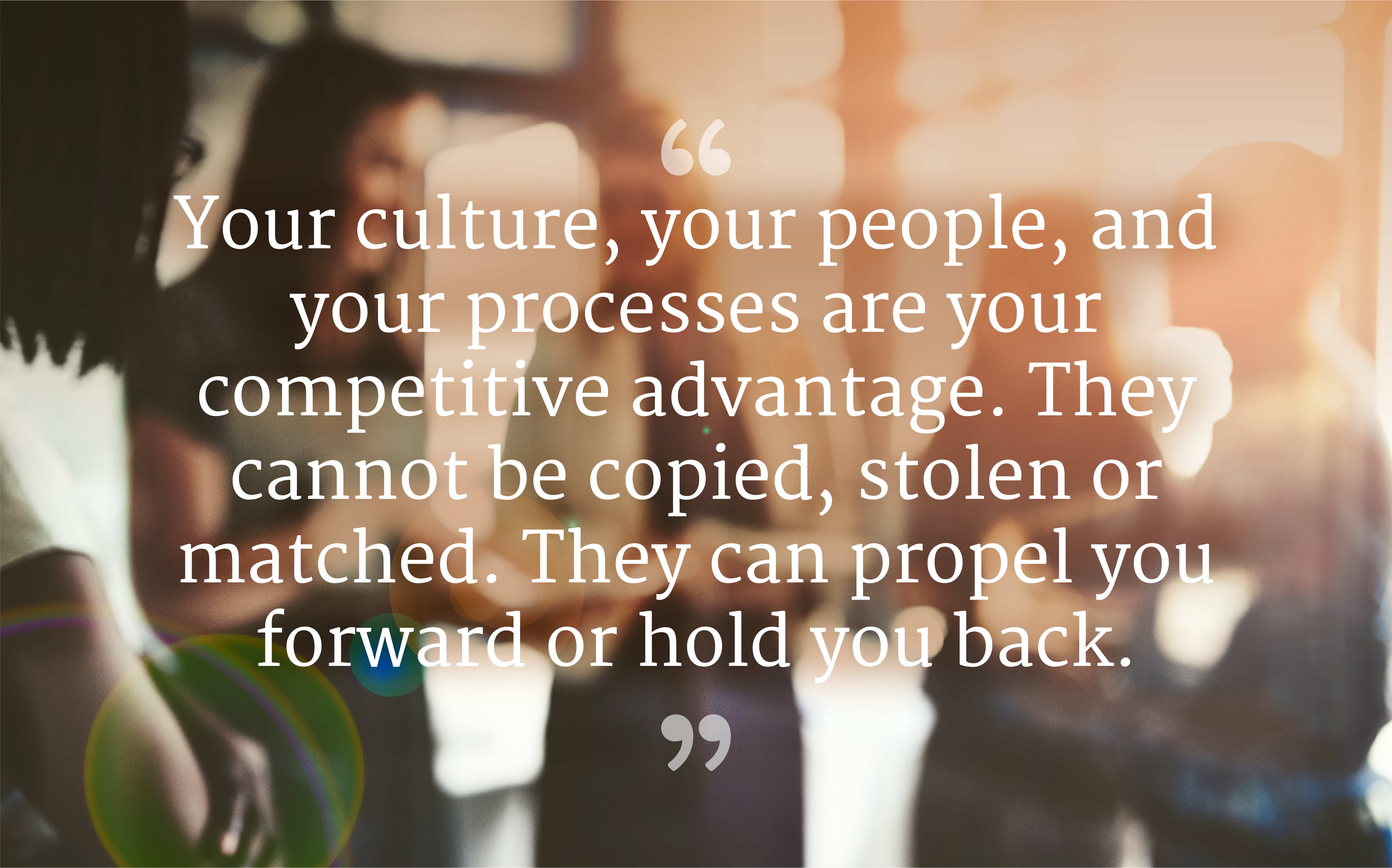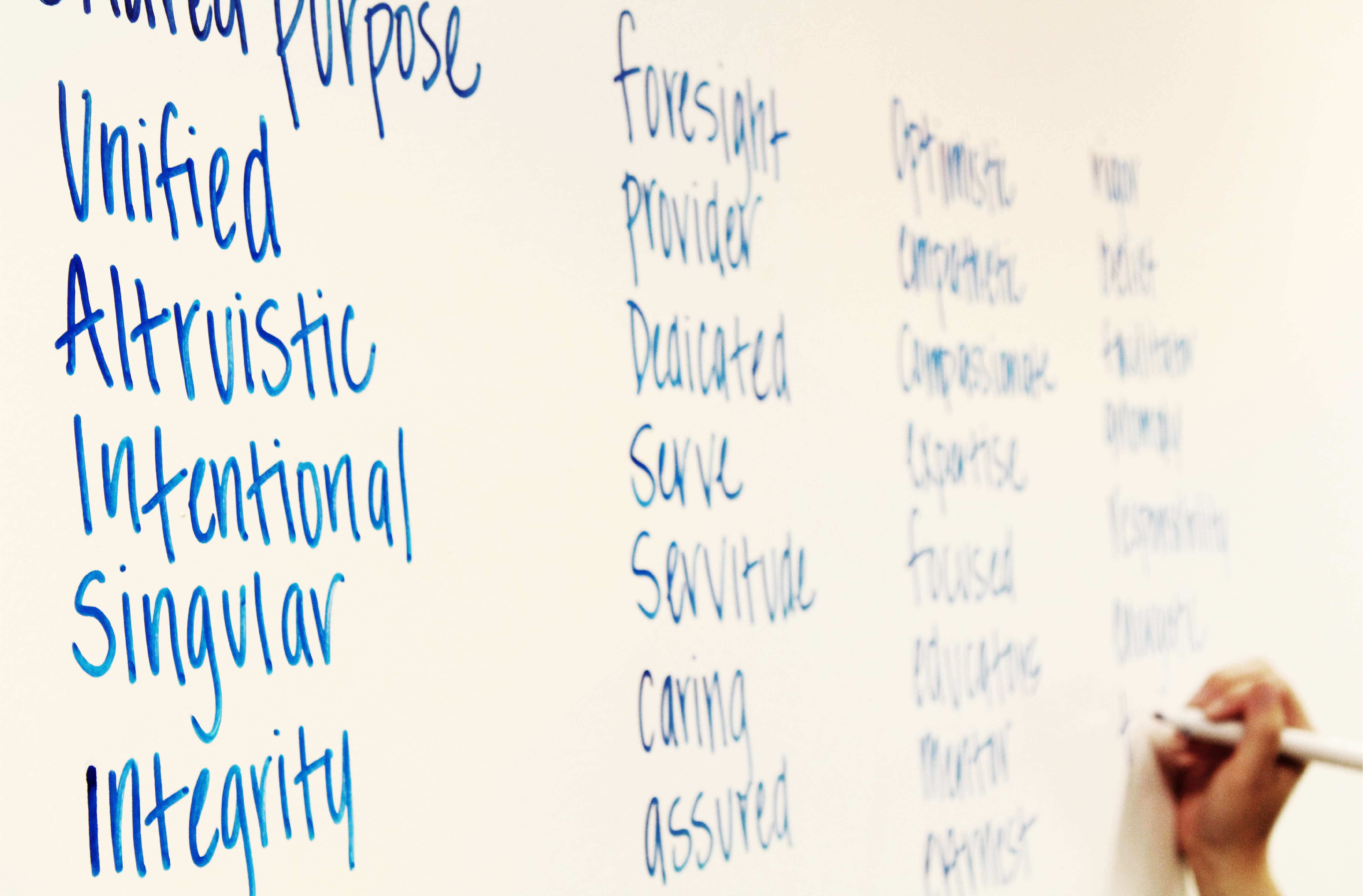How to steer your brand through marketing’s most pressing paradigm shift.
Most companies invest a great deal of time, money and effort into understanding everything that’s influencing their company from the outside: the market, competitors, customers, trends, and insights. But they often overlook questions about themselves: What is the culture of their own organization? What are the ethics and ambitions of their people—from leadership to middle management and the front lines? What inspires them, makes them proud of what they do, and what stands in the way of them contributing more?
These questions are important because your culture, your people, your processes are your competitive advantage. They cannot be copied, stolen or matched. They can propel you forward or hold you back. The more you know about what makes your organization and your people tick, the greater your ability to inspire, motivate and empower them. Getting this right is the first step in becoming a Collaborative Brand. Because knowing who you are is the first step in being able to relate to the people on the other side of your business: your customers. It allows you to find common ground, tackle shared challenges, and work together to evolve relationships and shape the future of your business and your industry.

But, to truly collaborate with your customers, you have to be willing to be open and transparent. You can’t hide as the wizard behind the curtain. You have to be willing to see every side of your organization. To learn what inspires your employees, what motivates them to show up to work every day, and discover the beliefs that are shared across locations, roles and responsibilities.
HOW DO YOU ACHIEVE TRUE TRANSPARENCY WITH YOUR CUSTOMERS?
YOU START BY LISTENING TO YOUR EMPLOYEES.
Marketers are quick to think in terms of broad business strategies, like vision, mission and values. They rarely stop to look and listen closely to the foundation of their business: their people, their culture, their values and beliefs. This is where great companies find a common language and cultural understanding, which can resonate as much inside the organization as it does outside.
Language and messaging are the foundation of business, the most vital elements of the sales process, but they are also critical to building a strong culture of people. Yet, most brands are perfectly content to allow external forces to set the tone and the language of the business. It’s an approach that says absolutely nothing—and at the same time absolutely everything—about who a company really is. It’s inauthentic and non-committal and reveals a lack of belief in who they are and what they represent.
Great companies, on the other hand, do not pander to their audiences. They take the time to understand who they are at their core and how they view themselves, their work and each other. This defines the context of their brand, the true value of their offering, and the contribution of their employees, so they can work in unison with their customers.
To be clear, digging beneath the surface of your organization, deep into the inner workings, the beliefs and behaviors of your people takes work. Understandably, it’s a challenge to make time for the important work of listening during the course of our day-to-day responsibilities, putting out fires, managing people, and identifying our next opportunities. This is the biggest reason why most companies don’t stop to assess and ask hard questions and miss their chance, day after day, to become something well beyond their competitors.
This is because the art of listening is an exercise in patience. You have to give people the time and space to talk. But you have to do more than listen, you have to probe to understand what motivates them, inspires them and frustrates them. This is where you will find the reasons behind their opinions and behaviors. And if you pay close attention, you will hear consistent themes across the organization about how people approach their work, their common enemies, shared biases, perceptions of leadership, ambitions and ethics, and the passions that brought them to the company in the first place.
BECOMING COLLABORATIVE WILL BE YOUR BIGGEST BRANDING BREAKTHROUGH
At Intrinzic, we believe there is intense power in a brand’s visual and verbal message, and it can become a major advantage for companies that think not just about what they say, but exactly how to say it and visualize it in ways that inspire employees, customers and the marketplace. Our collaboration sessions with clients include deep discussions with leadership, managers and front-line employees. The discussions don’t dwell on products, services and the marketplace, they instead get to meaning, motivation, philosophy and passions. Our tools help organizations better articulate their culture to identify their core attributes—a set of words and images that when brought together, universally define the unique motivations and ethic of their organization while expressing the relevance and value of the company and its people.

This work requires our team to have deep knowledge and understanding of the meaning and perceptions of language and the many ways it can be articulated in messaging and design so that we can find ways to articulate value within the context of the organization and its sub-narratives. Then we can identify the intent of the brand, and frame ideas in ways that are both authentic, provocative and inspiring.
When we talk about collaborative brands, we’re not just talking about a novel approach to branding. It is a clear response to the evolution of the marketplace, where the corporate pursuit of growth and expansion has had a way of dehumanizing the very people marketers are trying to build relationships with. This approach to marketing and optimizing has created a major chasm between brands and the people, industries and communities they serve. Most brands have become so removed from their customers—objectifying them as segments and insights and actions to be optimized—that there is nothing left for people to believe in. There is no connection, no feeling, no relationship.
COLLABORATIVE IS THE NEW BRAND IMPERATIVE
The news gets even more challenging when you look at the commoditization of virtually every industry and marketplace. Customers have an endless supply of choices. Every conceivable option to fill every conceivable need at every price and at every level of quality. The products and services available today are at the highest level of quality and consistency in history. The difference between product A and product B is becoming nearly impossible for customers to identify, much less understand. So that leaves customers with one of two ways to make a decision: price (which means they see essentially no difference between you and your competitors), or the far more differentiating and valuable elements of confidence, belief, relationship and connection.
The latter can’t be found on a list of features and benefits. They can only come from a clear articulation of your organization’s approach, the motivations of your people, the power of your culture and your explicit beliefs as an organization. They are “intangibles” and they’re the most powerful and unique asset you have. They’re the reason why customers are willing to pay more to work with you. They are what can make you a truly collaborative brand.

Apple is an obvious example, with people willing to pay considerably more for their products than comparable (and arguably higher spec) mobile phones, PCs and tablets. Apple is abundantly clear in every aspect of their organization that they represent the pursuit of creativity and innovation—in their messaging and hiring, from leadership to the employees in their retail stores, with high-end design to their innovative functionality. This is equally true of companies like Yeti (some of the most expensive coolers in the world), Patagonia, Harley Davidson, Disney and many others. They consistently command a premium for the relationship they have built with their customers. Even in the B2B space, where it often feels like price wins out over every other benefit, collaborative brands like IBM, SalesForce and Cisco also command premiums for their services despite an onslaught of less expensive providers.
This new reality means brands can no longer simply pander to customers’ momentary interests with an endless stream of incremental improvements, me-too features and mind-numbing benefits. If a company wants to win in today’s environment they must have deep convictions that they share with their customers and their employees. They must overtly pursue the same interests and passions as their customers, aligning their entire organizations around them, innovating around them, hiring people based on them, and ultimately inspiring the industry around them.
BEYOND PRODUCT, BEYOND SERVICE, IS BELIEF
You may be thinking that building a collaborative brand would be easy if you had a sexy product or service to sell. Of course every company wishes they had the passion and culture that Harley Davidson or Patagonia share with their customers. But let’s make one thing clear: passion has very little to do with “what” you make or do. Some of the most powerful and successful collaborative brands we work with are B2B companies, whose people, service and impact is deeply felt with every project, product and interaction.
We have a large client in the construction industry who truly lives up to their role as a collaborative brand. The people in this organization—from the CEO to the craftspeople—are as passionate about their work, if not more so, than anyone you will ever meet at even the most progressive consumer goods company. Their team is clear in focus, purpose and vision. They hire people with a certain mindset and empower them to build and enhance the quality of their work. In turn, they inspire and improve their team’s work and the company’s work. Together they are all setting the standard for their industry, participating in building a community of politicians, corporate interests, and environmentalists who believe in them—the way they work, how they train, how they support each other, and how they align the needs and values of their substantial clients with even more substantial infrastructure projects. Their passion is infectious and ingrained in their brand, their culture and their people. This facilitates direct connections with the beliefs and ambitions of the organizations and institutions they work with. The best news is that it has driven exponential growth for the company as they surpass a billion dollars. Their clients state again and again that it is this shared vision and beliefs that drew them to the company.
This company, along with many of the organizations we work with, didn’t just find their passion in “what” they do. Instead they found it in “how” they do it: in the details, the team work, the way they rely on one another, and build each other up. This mindset and the messaging that expresses it took them from being a company that merely builds bridges and roadways to a massive organization that builds the infrastructure for entire communities, transforming entire regions. It also demonstrates why collaboration is such a hard thing for companies to achieve. It requires a completely different way of thinking on the part of everyone in your organization, not just about your brand, but about your people and the culture they create.
IT’S TIME TO GO BACK TO THE START
So the question we ask every company we work with is this: do you really know yourself? The answer is as consistent as it is surprising. Either it’s a resounding no or a list of generic values that leadership wants to be true. It’s at this moment when it becomes clear that it’s time to go back to the beginning, and do the one thing that will always bring you closer to your customers: understand yourself to find out what you have in common with them.

